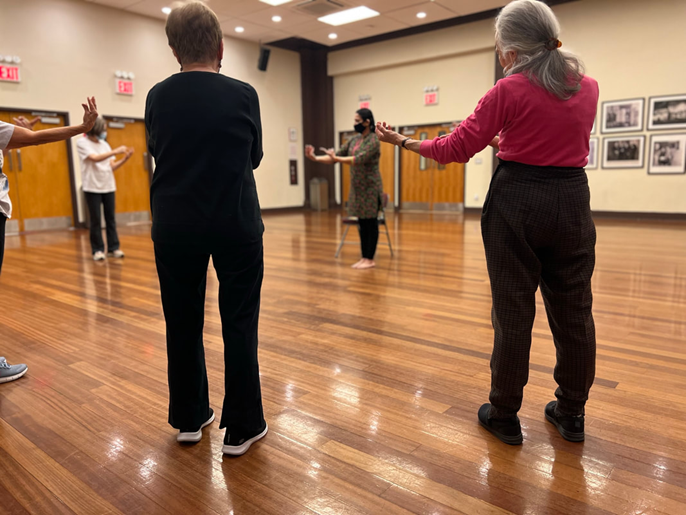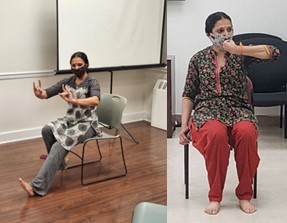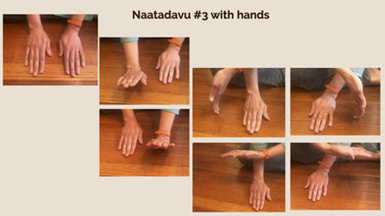Blog by Sloka S. Iyengar PhD, PMP
In the relatively new field of “creative aging,” older adults participate in pursuits such as painting, drawing, knitting, writing, music, and dance. Creative aging programs aim to engage seniors in activities that promote resilience and plasticity. Some programs cater to specific populations, e.g., those with Parkinson’s Disease,1 whereas others are meant for older adults in general.2 Successful programs offer physical activity, socialization, and confidence-building. They also provide an escape from participants’ duties and stave off potential physical maladies. But most importantly, they teach new skills and the ability to use these skills for self-expression. This article describes my experiences teaching Bharatanatyam dance to older adults. I detail the benefits I have seen first-hand as a teacher and practitioner of the art: enhanced powers of observation and expression, improvement in fine motor skills, positive physical and social well-being. I believe Bharatanatyam should be more widely considered under the umbrella of creative aging programs because it offers unique and unexplored advantages that make it ideal for a creative aging program.
Bharatnatyam is a classical Indian dance form that includes storytelling through music, rhythm, movement, visualization, percussion, and a codified language of emotions (Navarasas). The feeling of devotion (bhakti) permeates all aspects of Bharatanatyam. We direct our bodies and minds towards something larger than ourselves through consistent practice, typically under the guidance of a guru. Bharatanatyam offers tremendous flexibility—pieces can be done solo, as a duet, or in a collective. For some pieces, we respond to the rhythm of the music in a percussive manner; other pieces may be “softer,” using hand gestures (hastas) and facial expressions to embody emotions and tell a story. These elements and the depth of the practice align with my participants’ sensibilities; they are interested in learning new things, extremely expressive, and eager to find ways to communicate through movement.
Bharatanatyam provides a new way for dancers to observe and perceive their environment, and even process emotions. For example, my New York City participants have told me that our sessions opened them to “seeing” the specific rhythmic patterns of the city’s subway. With this group of dancers, I developed a series of workshops called “Rasas in Real Life” that enabled us to think of our life experiences in light of the emotions they evoke. For example, by thinking about how humor (hasya) may be embodied in our lives or on stage, particularly the nuances of laughter (coy smile, sarcasm, condescension, silliness), participants reported being able to engage with the world around them through dance. We took inspiration from our surroundings by noting visually humorous poses of tourists absorbed in their maps and selfies while neglecting to take in the city. Old age can be associated with disengagement, as the world often seems to have shifted its attention to the next generation. Dancers that have been working with me for a while willingly take on the responsibility of teaching newer participants, which helps them socialize, build inclusive communities, and combat loneliness.
By incorporating hand gestures and specific eye movements, Bharatanatyam can help participants to develop and practice fine motor skills. Hastas, or hand gestures, are an integral part of Bharatanatyam. While some hastas (e.g., the crown of a king using tripataka) may not be directly relevant to a contemporary audience, participants could show the difference between a king (as they perceive it) and a child acting like a king. One of my dancers used tripataka to show a selfie stick! Figure 1 shows participants learning how to use their hands to show modaka (a dumpling). Students of Bharatanatyam are also trained to pay attention to their eyes, especially how their eyes appear to an audience; our goal in this practice is to make our gaze expansive, not limiting.

Many pieces in Bharatanatyam tell a story through multiples modalities—hastas, melody (raga), and rasas—challenging participants to engage their entire bodies. With one group, the dancers and I co-choreographed a piece that portrays different animals through rhythm, movement, and facial expressions. We first show the animals, and then through the immersive qualities of Bharatanatyam eventually “become” these animals (Figure 2). Participants often talk about “words not being enough” to describe their feelings. Bharatanatyam offers them a non-verbal avenue to make sense of the world around them. Anecdotally, dancers who are caregivers for their partners mention that in their day-to-day lives they are often thinking of numerous things at the same time. Bharatanatyam gives them an opportunity for deep immersion, which they find both challenging and fulfilling.

Movement is beneficial for seniors to promote balance and stability. Seniors who move often also have more confidence and report enhanced balance and stability.3 To ensure that participants of all levels of mobility are comfortable with the movement patterns of Bharatanatyam, the sequence of movements (jatis) can be adapted for only the hands (Figure 3). Practicing movement patterns seated allows participants to familiarize themselves with the intricate rhythms, and gain confidence to do them standing.

In time, I hope that Bharatanatyam-based creative aging programs will become an important part of the burgeoning social prescription movement.4 The depth inherent in the form gives practitioners the freedom to choose certain aspects of Bharatanatyam and apply them in a setting for older adults. These applications include focusing on the rhythmic aspects of the dance when seated, meditating on emotions through the language of Navarasas, using the eyes and the hands to tell stories, and above all, using our bodies and minds to make a spiritual offering. Bharatanatyam gives all participants, but specifically older adults, the tools and the confidence to age gracefully and creatively.
References
[1] Ana Paula S. Pereira et al., “Music Therapy and Dance as Gait Rehabilitation in Patients With Parkinson Disease: A Review of Evidence,” Journal of Geriatriatric Psychiatry and Neurology 32, no. 1 (January 2019):49-56, https://doi.org/10.1177/0891988718819858.
[2] Michèle Mattle et al., “Association of Dance-Based Mind-Motor Activities With Falls and Physical Function Among Healthy Older Adults: A Systematic Review and Meta-analysis,” JAMA Network Open 3, no. 9 (September 2020): e2017688, https://doi.org/10.1001/jamanetworkopen.2020.17688.
[3] Chifen Ma et al., “The Effect of Rhythmic Movement on Physical and Cognitive Functions among Cognitively Healthy Older Adults: A Systematic Review and Meta-analysis. Archives of Gerontology Geriatrics 104 (January 2023): 104837, https://doi.org/10.1016/j.archger.2022.104837.
[4] J. Matt McCrary, Emma Redding, and Eckart Altenmüller, “Performing Arts as a Health Resource? An Umbrella Review of the Health Impacts of Music and Dance Participation. PLoS One 16, no. 6 (June 10, 2021): e0252956, https://doi.org/10.1371/journal.pone.0252956.
Sloka Iyengar is a neuroscientist and dancer, passionate about relieving suffering through the sciences and the arts. She is creating the foundation for the use of Bharatanatyam for creative aging and has developed productions that explore the intersections between the arts and neuroscience. Sloka is also an Aseemkala Initiative fellow; Aseemkala Initiative aims to transform medicine through traditional dance. More about Sloka’s work can be found here: https://www.slokaiyengar.net/